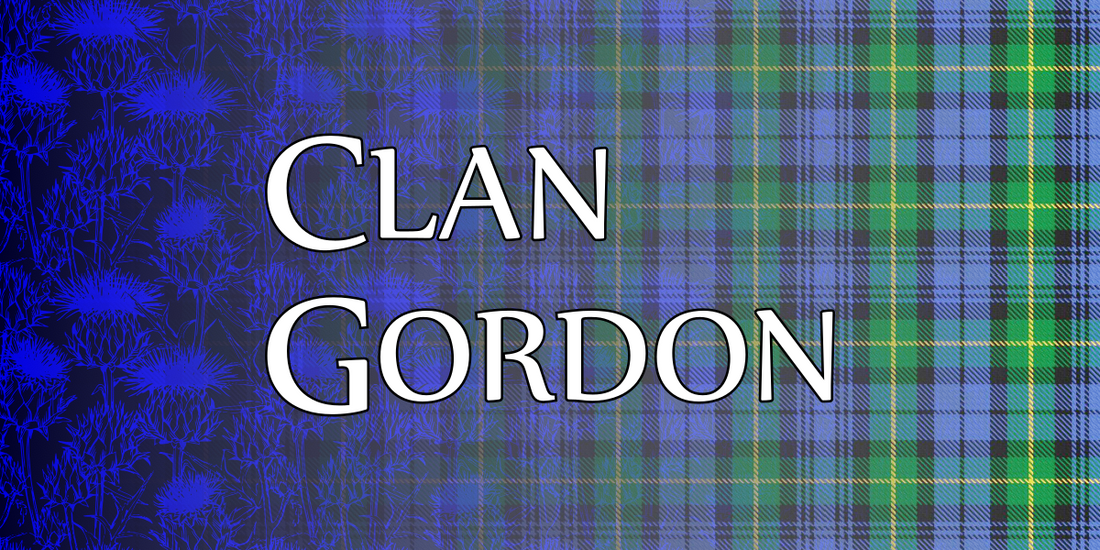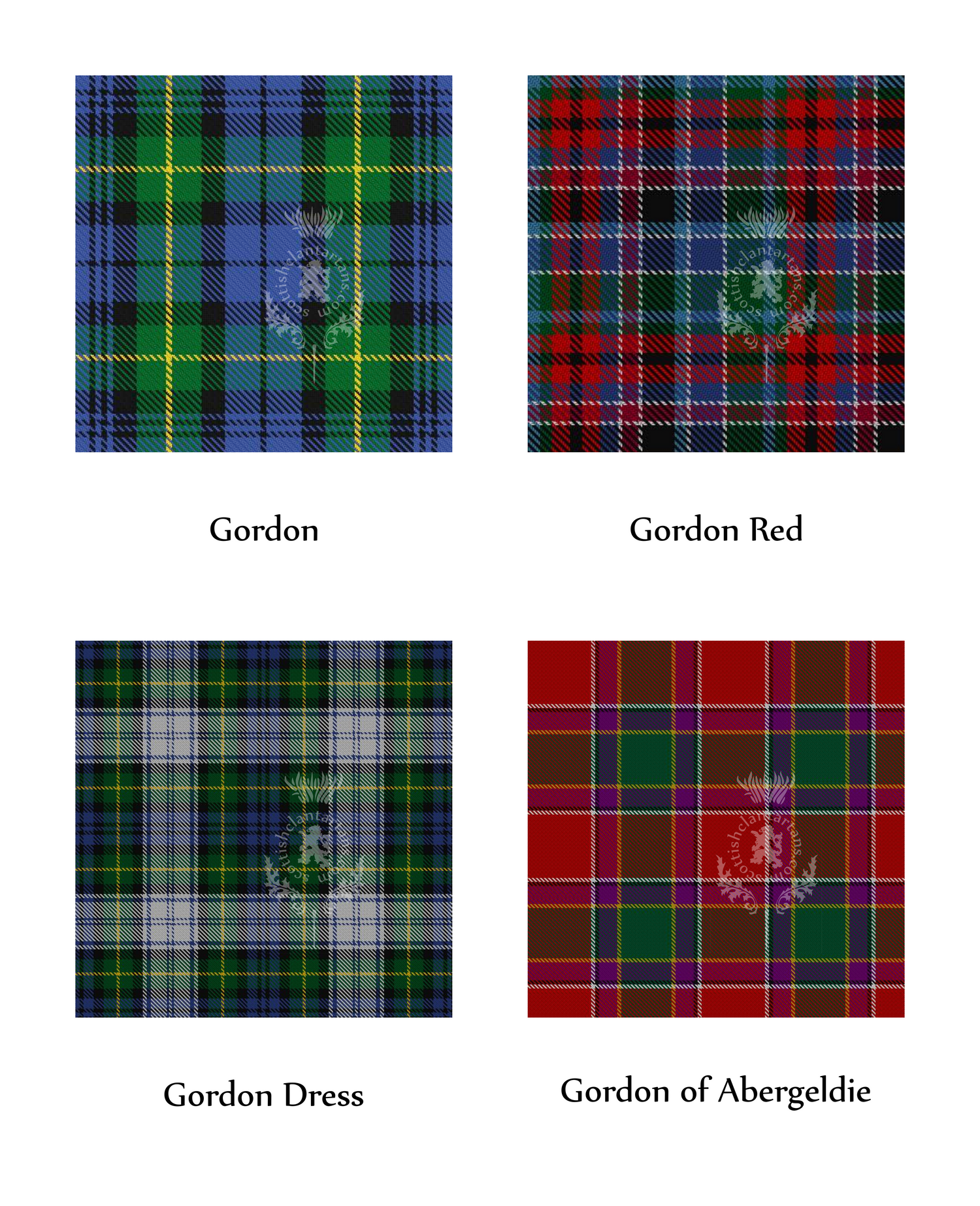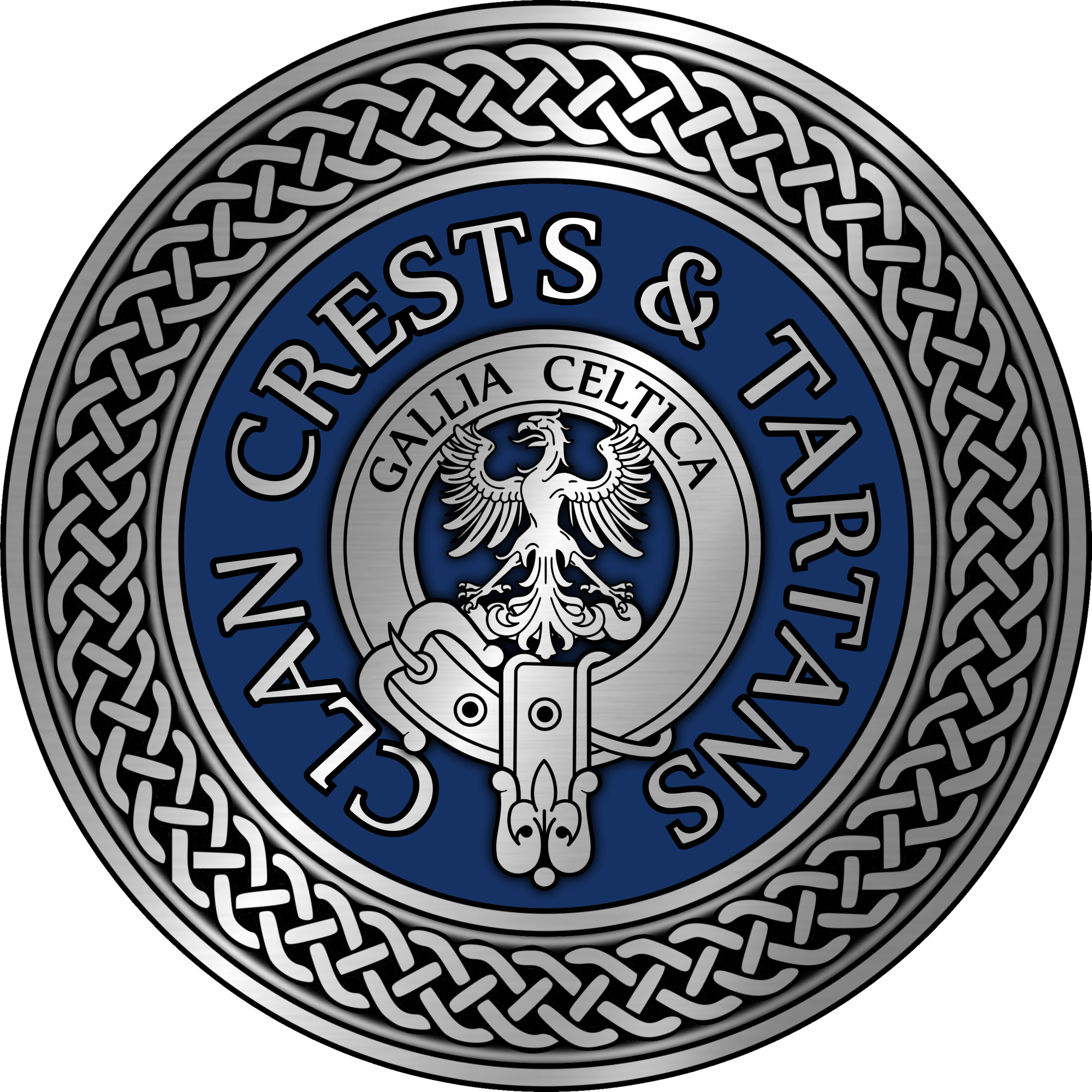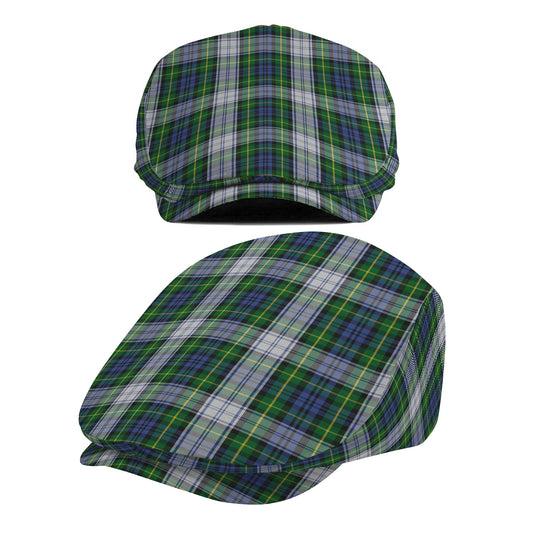

Scots Gaelic: Na Gòrdanaich
Clan Gordon is a Highland Scottish clan, historically one of the most powerful Scottish clans. The Gordon lands once spanned a large territory across the Highlands. Presently, Gordon is seated at Aboyne Castle, Aberdeenshire. The Chief of the clan is the Earl of Huntly, later the Marquess of Huntly.
During the Wars of Scottish Independence in the 13th century, the Gordons supported William Wallace in the cause of independence. In the 15th century, the chiefship of the clan passed to an heiress, who married into the Seton family and her male descendants assumed the surname Gordon and continued as chiefs of the clan. The Gordons assisted in defeating the rebellion of the Earl of Douglas also in the 15th century. In the 16th century, the Gordons as Catholics feuded with their Protestant neighbors the Clan Forbes and also defeated at the Battle of Glenlivet, the Protestant Earl of Argyll. During the Wars of the Three Kingdoms of the 17th century, the Gordons supported the Royalist cause. During the Jacobite rising of 1715 the Clan Gordon was Jacobite. During the Jacobite rising of 1745, their chief, then the Duke of Gordon, pledged his support to the British-Hanoverian Government, but his clan remained Jacobite.
Profile
Crest: Issuant from a crest coronet Or a stag's head (affrontée) Proper attired with ten tines
Motto: Bydand (abiding, steadfast, an adjectival use of the Middle Scots present participle of bide or a contraction of the Scots phrase 'Bide and Fecht,' meaning "Stay and Fight".) Animo non Astutia (By Courage not by craft)
Slogan: An Gòrdonach
Plant Badge: Rock Ivy
Region: Highlands District, Aberdeenshire
Pipe Music: "The Gordon's March", "Cock o' the North"
Historic Seat: Huntly Castle
Seat: Aboyne Castle
Chief: The Most Hon. Granville Charles Gordon, 13th Marquess of Huntly (An Gòrdonach)
Clan Relationships
Branches
Gordon of Huntly (chiefs)
Gordon of Aboyne
Gordon of Aberdeen and Temair
Gordon of Kenmure
Gordon of Auchindoun
Gordon of Abergeldie
Gordon of Haddo
Gordon of Glenbuchat
Gordon of Gight
Gordon of Rothiemay
Septs
Ackane, Adam(son), Ad(d)ie, Addison, Adkins, Aiken, Aitchison, Aitken, Akane, Akins, Atkin, Atkins(on), Badenoch, Barrie, Connor, Connon, Craig, Cromb(ie), Cullen, Culane, Darg(e), Dorward, Durward, Eadie, Ed(d)ie, Edison, Esslemont, Fettes, Garden, Gard(i)ner, Garioch, Garr(o)ick, Geddes, Gerr(y)ie, Haddo(w), Huntl(e)y, Jessiman, Jopp, Jupp, Laurie, Lawrie, MacAdam, Mallett, Manteach, Marr, Maver, Mill, Mills, Milles, Miln(e), Milner, Moir, More, Morrice, Muir, Milnes, Mylne, Steel(e), Teal, Tod(d), Troup
Allied Clans
Seton, Sutherland, Burnett, MacDonald of Keppoch
Rivals
Lindsay, Douglas, Forbes, Leask, Campbell, Maitland

Clan Tartans
Shop Gordon TartansClan History
The first Gordon on record is Richard of Gordon, previously of Swinton, said to have been the grandson of a famous knight who slew some monstrous animal in the Merse during the time of King Malcolm III of Scotland. This Richard was Lord of the Barony of Gordon in the Merse. Richard de (of) Gordon probably died around 1200. Between 1150 and 1160 he granted from his estate a piece of land to the Monks of St. Mary at Kelso, a grant which was confirmed by his son Thomas Gordon. Other notable Gordons from this time include Bertram de Gordon who wounded King Richard of England with an arrow at Châlons.
Alicia Gordon, IV of the Gordon family was the heiress who married her cousin, Adam Gordon. Adam Gordon was a soldier who King Alexander III of Scotland sent with King Louis of France to Palestine. One tradition is that from Adam's grandson, Sir Adam, all of the Gordons in Scotland are descended. This Adam Gordon supported Sir William Wallace in 1297 to recapture the Castle of Wigtown from the English and Adam was made the Governor.
Wars of Scottish Independence
During the Wars of Scottish Independence Sir Adam Gordon, who had supported William Wallace, renounced his subsequent acceptance of the claims of Edward I of England and became a staunch supporter of Robert the Bruce. Adam was killed leading the Clan Gordon at the Battle of Halidon Hill in 1333 but his son Sir Alexander Gordon escaped and was the first Gordon to be designated "of Huntly".
Chief Sir John Gordon was killed leading the clan at the Battle of Otterburn where the English were defeated in 1388. His son, Chief Sir Adam Gordon, was killed leading the clan at the Battle of Homildon Hill, also known as the Battle of Humbleton Hill on 14 September 1402. The chief left his only child, a daughter named Elizabeth Gordon who married Alexander Seton, who was the son of Sir William Seton, chief of Clan Seton.
Gordon Collection
-
Clan Gordon Tartan Girl's Pajama suit
Regular price €34,95 EURRegular priceUnit price per -
Clan Gordon Dress Tartan Flat Cap
Regular price €43,95 EURRegular priceUnit price per -
Clan Gordon Tartan Wrapping Papers
Regular price From €13,95 EURRegular priceUnit price per -
Clan Gordon Tartan Socks
Regular price €13,95 EURRegular priceUnit price per
15th Century and Clan Conflicts
The Battle of Arbroath was fought in 1445 where Patrick Gordon of Methlic, a cousin of the Earl of Huntly, was killed fighting the Clan Lindsay. From this Patrick Gordon the Earls of Aberdeen descend.
In 1449 Alexander Seton, 1st Earl of Huntly, the eldest son of Elizabeth Gordon and Alexander Seton, Lord Gordon, changed the family name from Seton to Gordon.c. 1457. His male heirs through his third wife Elizabeth Crichton continued to bear the name of Gordon and were chiefs of Clan Gordon.
The chief of Clan Lindsay, Alexander Lindsay, the 4th Earl of Crawford, was badly defeated by the Clan Gordon and Clan Ogilvy under Alexander Gordon, 1st Earl of Huntly (previously Alexander Seton) at the Battle of Brechin in 1452.
The Gordons became involved in the deadly feud between the king and the Clan Douglas for power. The Gordons supported the king but when Gordon moved his forces south, the Earl of Moray who was an ally of the Douglases devastated the Gordon lands and burned Huntly Castle. However, the Gordons returned and soon defeated their enemies. Huntly Castle was rebuilt and when the Douglases were finally defeated the power of the Gordons grew unchallenged. In 1454 the Douglasses broke out in rebellion again and when confronted with the king in the south and Huntly in the north were soundly defeated, effectively ending the confederacy of the Douglasses, Rosses and Crawfords. For his notable contributions Alexander Gordon, 1st Earl of Huntly was styled Cock o' the North, a designation which has ever since been accorded to the heads of clan Gordon.
16th Century and Clan Conflicts
In 1513, during the Anglo-Scottish Wars, the Clan Gordon led by Alexander Gordon, 3rd Earl of Huntly fought at the Battle of Flodden.
In 1515, the title of Earl of Sutherland and chiefship of the Clan Sutherland passed by right of marriage to Adam Gordon who was a younger son of George Gordon, 2nd Earl of Huntly.
Later during the Anglo-Scottish Wars, George Gordon, 4th Earl of Huntly defeated an English army at the Battle of Haddon Rig in 1542 but the Gordons were later part of the Scottish army which was defeated at the Battle of Pinkie Cleugh in 1547.
Chief George Gordon, 4th Earl of Huntly was General of the forces on the Borders who opposed the forces of Henry VIII of England and Gordon had many victorious encounters. He was however later killed at the Battle of Corrichie in 1562 fighting against the forces of James Stuart, Earl of Moray (half-brother to Mary Queen of Scots). Gordon was killed and his son, Sir John, and other members of his family were later executed at Aberdeen.
Throughout the 16th century the Clan Gordon were involved in a long and bitter struggle against the Clan Forbes. In the 1520s there were murders by both sides, and one of the most prominent killed by the Forbeses was Seton of Meldrum who was a close connection of the Earl of Huntly, chief of Clan Gordon. The Earl of Huntly then became involved in a plot against the Master of Forbes, who was the son of the sixth Lord Forbes. The sixth Lord Forbes had been heavily implicated of the murder of Seton of Meldrum. The Master of Forbes was accused by the Earl of Huntly of conspiring to assassinate James V of Scotland in 1536 by shooting at him with a cannon. The Master of Forbes was tried and executed however just days later his conviction was reversed and the Forbes family was restored to favor. The Protestant Reformation added to the feud between the Clan Forbes and Clan Gordon in that the Gordons remained Catholic and the Forbeses became Protestant. The traditional enemies of the Forbses such as the Clan Leslie, Clan Irvine and Clan Seton sided with the Gordons while Protestant families such as the Clan Keith, Clan Fraser and Clan Crichton sided with the Clan Forbes. Twenty Gordons were killed at a banquet held at the Forbes's Druminnor Castle in 1571. Later in 1571 the feud climaxed with the Battle of Tillieangus, and the Battle of Craibstone, and Druminnor, then the seat of the chief of Clan Forbes was plundered. The Gordons followed this up with the massacre of twenty seven Forbeses of Towie at Corgarff Castle. It took two Acts of Parliament for the clans to put down their arms.
For two centuries from the mid-15th century the Clan Gordon and Clan Campbell controlled the north-east and west of Scotland respectively, as the magnates who straddled the divide between the Scottish Highlands and Scottish Lowlands. In 1594, Archibald Campbell, 7th Earl of Argyll was granted a Royal Commission against George Gordon, 6th Earl of Huntly but was defeated at the Battle of Glenlivet.
17th Century and Civil War
The register of the Privy Seal records that in 1615 a complaint was made from Alexander Leask of the Clan Leask that Adam Gordon, brother of the Laird of Gight, put violent hands upon him at the Yet of Leask, wounding him grievously. Later that year the Gordons again attacked the Leasks, setting upon a son of the chief for which George Gordon was outlawed. In 1616, William Leask of that Ilk was accosted by John Gordon of Ardlogy and a party of men with pistolets and hagbuts.
In the early 17th century Clan Gordon had a number of alliances by marriage or friendship. Among these was a strong bond to the Clan Burnett of Leys. The Gordon crest is emblazoned in plasterwork on the ceiling of the early 17th century great hall of Muchalls Castle built by Alexander Burnett.
In 1644 Alexander Bannerman of Pitmedden fought a duel with his cousin, Sir George Gordon of Haddo, and wounded him. Also in 1644 during the Civil War at the Battle of Aberdeen there were Gordons on both sides. Lord Lewis Gordon led his forces on the side of the Covenanters while Sir Nathaniel Gordon led his forces in support of the Royalists.
During the Civil War the second Marquess of Huntly was a fierce royalist and his followers have passed into history as the Gordon Horse and they figured very prominently in the campaigns of the great James Graham, 1st Marquess of Montrose. Cavalry from the Clan Gordon fought in support of the royalists at the Battle of Auldearn in 1645 where they helped to defeat the Covenanters of Lord Seaforth. The Clan Gordon fought at the Battle of Alford in 1645 where they were victorious, led by George Gordon, 2nd Marquess of Huntly. The Marquess of Huntly's eldest son George Gordon fell at this battle. Also in 1645, Lewis Gordon, clan chief and 3rd Marquess of Huntly burned Brodie Castle of the Clan Brodie.
In 1682 William Gordon of Cardoness Castle, was killed in a fight with Sir Godfrey McCulloch. McCulloch fled Scotland for a time, but returned, only to be apprehended and executed in 1697.
18th Century and Jacobite Uprisings
1715 Jacobite Rising
The Gordons fought on both sides during both the Jacobite rising of 1715 and the Jacobite rising of 1745. The second Duke of Gordon followed the Jacobites in 1715 and fought at the Battle of Sheriffmuir. General Wade's report on the Highlands in 1724, estimated the clan strength at 1,000 men.
1745 Jacobite Rising
Cosmo Gordon, 3rd Duke of Gordon supported the British Government during the rising of 1745. However, his brother, Lord Lewis Gordon, raised two Jacobite regiments against the Hanoverians. The Gordon Jacobites fought at the Battle of Inverurie (1745), the Battle of Falkirk (1746) and the Battle of Culloden (1746).
British Army Regiments
Two regiments named the "Gordon Highlanders" have been raised from the Clan Gordon. The first was the 81st Regiment of Foot (Aberdeenshire Highland Regiment) formed in 1777 by the Hon. Colonel William Gordon, son of the Earl of Aberdeen and was disbanded in 1783. The second was the 92nd (Gordon Highlanders) Regiment of Foot raised by Alexander the 4th Duke of Gordon in 1794.
Gordon Collection
-
Clan Gordon Tartan Girl's Pajama suit
Regular price €34,95 EURRegular priceUnit price per -
Clan Gordon Dress Tartan Flat Cap
Regular price €43,95 EURRegular priceUnit price per -
Clan Gordon Tartan Wrapping Papers
Regular price From €13,95 EURRegular priceUnit price per -
Clan Gordon Tartan Socks
Regular price €13,95 EURRegular priceUnit price per




